Reflections on the Upper Skagit: Ross Lake by Boat and Boot
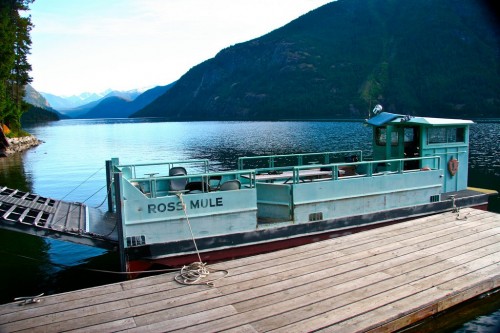 Written by Special Guest Blogger Elisabeth Keating.
Written by Special Guest Blogger Elisabeth Keating.
On a cool Thursday evening in late July, a group of adventurers gather at the Environmental Learning Center for the 24th (and possibly final) year of one of North Cascades Institute’s most popular courses: Ross Lake By Boat and Boot a three-day exploratory workshop on the people and places of the Skagit River Valley, led by Gerry Cook and Bob Mierendorf. Both Bob and Gerry have had celebrated careers with the National Park Service – Bob is in his 25th year as the North Cascades National Park Archaeologist, and Gerry, recently retired from 44 years as a Park employee, has been a North Cascades fire lookout (1967 and 1971), a Park designer and architect, and an instructor and captain of the Ross Lake Mule. Bob and Gerry have led this class since 1997, labeled fondly by those who know them as The Bob and Gerry show.
At orientation, Bob welcomes us to what he and Gerry call Up River University: Nature’s classroom in general, and the floating classroom on board the Ross Lake Mule in particular. In our handout is an essay about the history of the area’s indigenous people, a map of today’s current Ross Lake, the class field itinerary, and a timeline of key events in the Upper Skagit reaching back 24,000 years to the present day. Before the creation of the dams along the Skagit River in the first half of the 20th century, the heart of the North Cascades was so rugged and inaccessible that few outsiders ventured in.
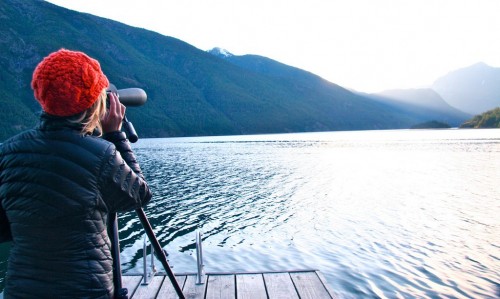 Looking out across the great expanse of Ross Lake on board the NPS Mule.
Looking out across the great expanse of Ross Lake on board the NPS Mule.
Gerry gives us a brief orientation to our home for the next few days – The Ross Lake Mule built in 1968. The North Cascades National Park inherited the NPS Mule from Katmai National Park in Alaska in 1976. The Mule hauled tons and tons of sand, gravel, cement, and materials of all kinds until it met its most noble calling: a floating wilderness classroom for students and adults.
The code name for the class that Bob and Gerry use is “Unnatural Axe. Says Bob, “We use it as a somewhat twisted metaphor, serving both humor (self-directed, of course) and inquiry into the history and ideas that we explore.” Our class floats over what was once a pristine forest, part of which still stands in an artificial lake and drowns ancient indigenous campsites in what was once a special gathering grounds in a northwest rain shadow ecosystem. The question then becomes: What is natural here? What is unnatural?
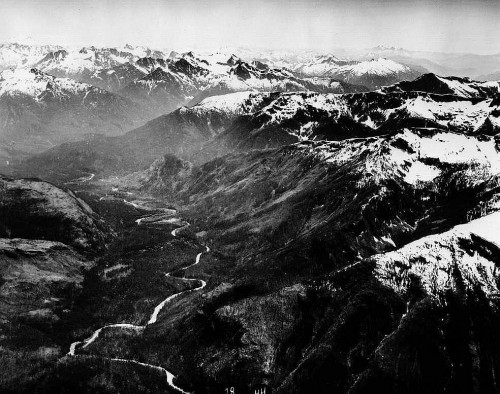 Bob’s slide show dramatically demonstrates how the upper Skagit River looked before the dams were built in the mid-20th century.
Bob’s slide show dramatically demonstrates how the upper Skagit River looked before the dams were built in the mid-20th century.
As an archaeologist, Bob has to work during the 6-week period every spring when the level of the reservoir is at its lowest in order to excavate and make discoveries. What we’ve learned (through our archeological work) is the importance of Hozomeen chert (flint) to Northwest economies on both sides of the North Cascades for the past 9,000 years, revealing that the upper Skagit Valley was used as an early mountain hunting and gathering ground for indigenous people.
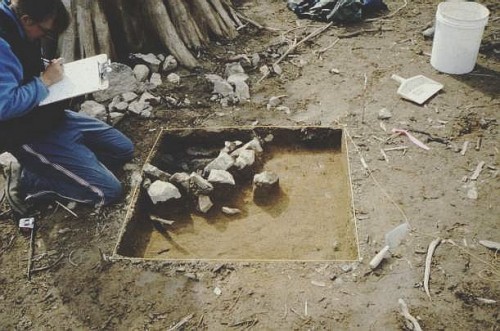 Bob’s excavation of a 1,600-2,000 year old cooking hearth. The location is undisclosed to protect the artifact from vandalism.
Bob’s excavation of a 1,600-2,000 year old cooking hearth. The location is undisclosed to protect the artifact from vandalism.
Friday morning we set forth from the Environmental Learning Center, hiking down to Ross Lake and boarding the NPS Mule. Adventure lost no time in finding us! Within an hour we are watching a black bear scampering along the shoreline! A few hours later, Bob leads us ashore to show us an archaeological site that he hypothesizes was used by the Native American wife of John McMillian, who lived in lower Big Beaver Valley. Then we’re back on the Mule to examine up close a clay deposit that had collapsed on the shoreline exposing layered strata and revealing the geology of the valley 20,000 years ago. At dusk we arrive at Lightning Creek Campground to set up camp, cook dinner, goof around on the bridge taking pictures, and share stories.
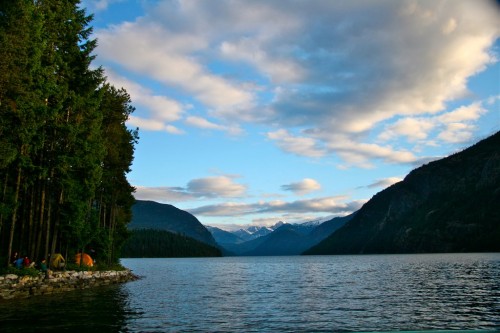 Lightning Creek Campground with our tents set up along the shoreline for panoramic views.
Lightning Creek Campground with our tents set up along the shoreline for panoramic views.
After breakfast on Saturday, Bob leads us on an ethnobotany hike along the lake. To the native people of the Skagit, nature was their hardware store, pharmacy, and grocery store. With Bob, we learn to stop and pay attention, to identify which plants indigenous people harvested and why. He points out that the kind of things we’re doing this weekend are shared with the experiences of our ancestors thousands of years ago. We can all relate to foraging in nature, staring into campfire embers, and slowing down to listen to owls and lake water. It’s good for our brains to unplug from the gadgets of modern society, to forage, explore, step carefully, pay attention to what’s going on around us. We start to reawaken senses and intuitions that we often ignore in our hectic lives.
 During an ethonobotany hike, Bob explains that, to the native people, “These forests were their hardware store, pharmacy, and supermarket.”
During an ethonobotany hike, Bob explains that, to the native people, “These forests were their hardware store, pharmacy, and supermarket.”
Using our handouts and plant identification guides, we walk slowly, staring intently at what we’d usually dismiss as uninteresting underbrush en route to a hiking destination. Libby Mills, a student in the course and regional bird expert who teaches field seminars at North Cascades Institute, deciphers bird songs and provides more insight into the chirping, cawing, hooting and teeming we hear in our surroundings. When we find something that looks interesting, we search for it in our reference guides and read the entry aloud. Soon my head and my notepad is abuzz with poetic names of plants and trees we’re seeing on our small walk. I jot down their uses to the early inhabitants of the Skagit:Choke cherry (expectorant and sedative), boxwood (used for tools), deerbrush (tobacco and soap), honeysuckle (cough medicine), Indian hemp (the fiber’s used to make fishing nets and ropes), service berry (useful as an ear medicine and cold remedy).
By the end of our walk, the class is feeling a whole lot smarter. If we lost Bob and Gerry, we could probably set up a pharmacy/hardware store for a week or two, no sweat!
After lunch and an impromptu trip to the Canadian border, we drink in the sunset over Hozomeen Glacier in our floating classroom. Bob gives an impromptu lesson in how to create knives and cutting utensils out of obsidian, a sharp lava rock that can be found in the North Cascades and has been used as a tool for almost as long as people have been in the New World, over 15,000 years.
 The NPS Mule docked at shoreline and hidden through the trees.
The NPS Mule docked at shoreline and hidden through the trees.
The next morning, the NPS Mule chugs across the lake once more, ferrying us to Big Beaver Creek. The trail up Big Beaver is a tunnel of green. About three miles in we enter one of the finest stands of ancient Western Red Cedar trees to be found anywhere on the planet. Some trees are over 15 feet in diameter and 1,000 years old. The class tries to hug a tree and it takes all of us to make a circle! Then it’s time to head back to the 21st century once more.
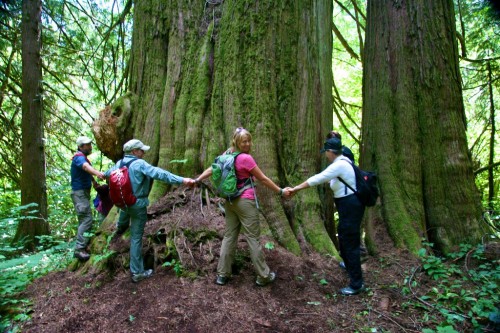 Circling around a 1,000 year old cedar.
Circling around a 1,000 year old cedar.
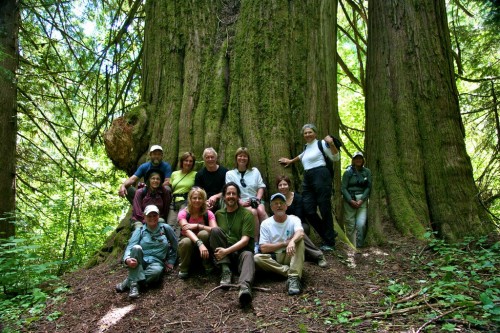 Gathering for lunch beneath the cedars trees.
Gathering for lunch beneath the cedars trees.
I ask Bob and Gerry to share some final thoughts on what may be their last year teaching the course together.
Says Gerry: Co-teaching really helps, as one of us can be a little off and the other can cover. Co-teaching also affords us a much larger spectrum of appeal to different people. Between the two of us, Bob and I can find a personal connection to almost all participants. We originally took the class to an historic site every year but after several years we realized we were creating a social trail to the site and, without the Park having a clear policy on this site, we quit taking people there. We did a moonlight cruise the first year which was a disaster as I could not see anything to get back to our camp.
Bob adds: Some people take our class many times and at first I was puzzled by that but have come to understand that one can only take in so much information at a time, and so yearly repeating of a similar message slowly sinks in over time.”
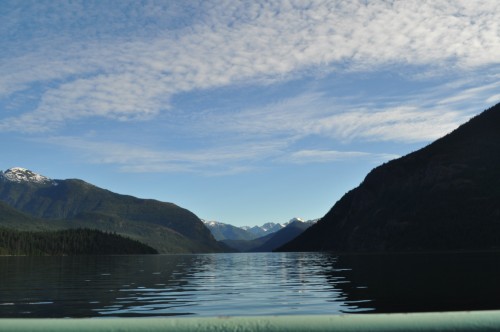 Last views of Ross Lake as we head back towards the Environmental Learning Center.
Last views of Ross Lake as we head back towards the Environmental Learning Center.
Back on the Mule and heading for a salmon dinner at the Environmental Learning Center, we eat candy bars and ponder the importance of unplugging from modern society for a few days. We share our fears about the dangers facing wilderness today and the fact that the huge blue, tranquil lake we’re floating on is a vast resource that will be increasingly coveted with global climate change. The past few days have been peaceful and serene. Outside our bubble, things don’t always look as sunny. Now that we know this place a little better, we see the lessons from earlier indigenous people that we can take back as newfound wisdom for the 21st century. We experienced what poet and writer Gary Snyder meant when he wrote, “There is more information of a higher order of sophistication and complexity stored in a few square yards of forest than there is in all of the libraries of mankind.
A student of the course once sent Bob and Gerry two bottles of wine with a note saying that after a weekend in Up River University, he’d quit his job and realigned his priorities. As he tells us this story Gerry chuckles. Just another day of a lifetime, in paradise.
Photo of historic upper Skagit Valley and photo of indigenous cooking hearth courtesy North Cascades National Park Archives.
All other photos courtesy Elisabeth Keating.


This was a wonderful trip indeed!! I hope that it /is/ repeated next year, the weekend fed my heart and my soul with good times, good people and good conversation.
what an amazing recounting of one of my favorite trips on Ross Lake with Captain Gerry ever! so many great details and photos. thanks so much for transporting us back to summer here on the first day of winter…
Reading Lisa’s blog brings back so many wonderful memories. It has provided me with another way to share my “trip of a life time” with others! Thank you Lisa for taking the time to describe our Ross Lake adventure and to Bob and Gerry for providing so much and sharing it with all of us!
Thank you for capturing the spirit of this trip, Lisa! What a gift. ♥
Lisa, I just discovered this story through your LinkedIn page. Thank you for writing such a vivid description of our spectacular three days adventuring in the North Cascades with Bob and Gerry. Reading this brings back many happy memories! I remember how good those candy bars tasted after our hike up Big Beaver to the great cedar forest and leap into freezing Ross Lake to cool off. Fingers crossed that we can all convince Gerry to “unretire” for a few days so this course comes back in the future!!